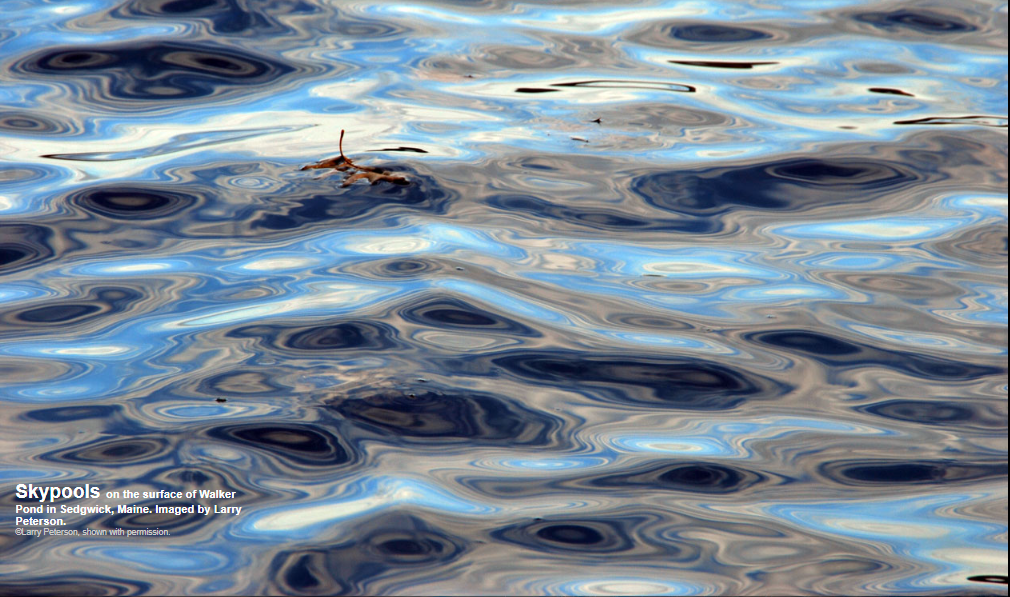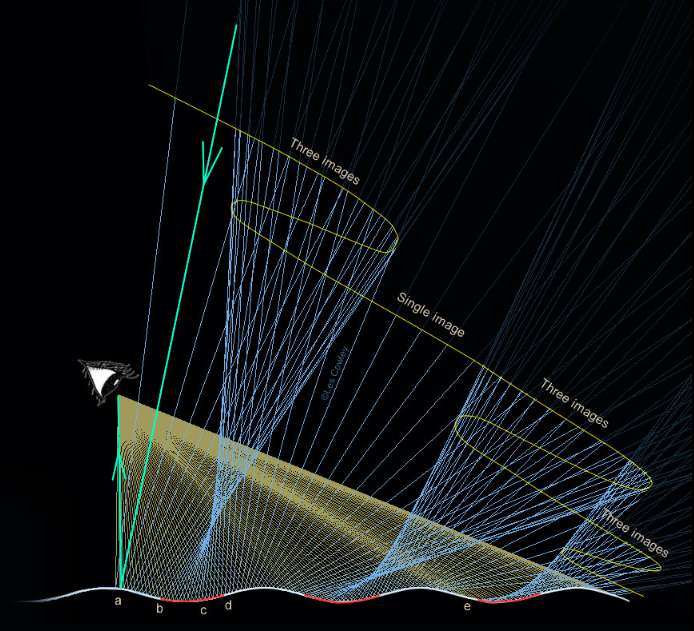OPOD - Sky Pools
OPOD - Sky Pools: A Detailed Look at the Complex Nature of Skypools
Skypools, such as the ones captured by Larry Peterson on Walker Pond in Sedgwick, Maine, are captivating natural phenomena that exhibit a mesmerizing play of colors and reflections. While they may seem like simple reflections of the sky and landscape, skypools are far more intricate and complex than meets the eye. These intriguing optical illusions are formed due to the unique shape and movement of the water surface, resulting in ovals of alternating colors that represent both the sky and the land.
Unlike ordinary mirrors with fixed curvatures that produce simple and single images, skypools are formed on wavy water surfaces that constantly change in curvature from point to point. The water's surface undulates with troughs and crests, creating a dynamic environment for light reflection. The troughs of the waves are concave at their deepest points, but as the water moves towards the crests, an inflection point is reached, and the curvature transitions to convex. This multidimensional alteration of curvature gives rise to the complexity and variety of reflections observed in skypools.
To understand the formation of skypools, let's delve into the ray diagram for a particular viewing position and cylindrical waves. The blue-colored rays represent light coming downwards from various directions in the sky, while the yellow rays depict their reflections upwards into the observer's eye. As we move our gaze from one point on a wave to another across the water surface, the reflections from points in the sky change in relation to the horizon.
- Moving from point "a" to point "b," the reflections come from points in the sky closer to the horizon, resulting in an inverted image.
- From "b" to "c," the reflected rays progressively come from higher points in the sky, creating an upright region of reflection.
- Continuing from "c" to "d" and beyond, the reflections again come from lower points in the sky as we look further along the wave, resulting in an inverted image.
- This pattern repeats in the next wave trough, generating more upright and upside-down sky views.
However, the complexity of skypools doesn't end there. At point "e," a new complication arises. Some rays are reflected twice by the water surface before reaching the observer's eye, adding additional images to the mix. While these twice-reflected rays are not shown in the diagram for clarity, they contribute to the overall complexity of skypool reflections.
In reality, bodies of water exhibit undulations of several wavelengths and extend in various directions, resulting in predominantly oval bands of different reflections. Larry Peterson's observation location on Walker Pond had dark trees, which were incorporated into some of his skypool images, transforming them into "landpools." Additionally, concentric ovals of reflected clouds and blue sky can be seen in other areas of the skypools.
Skypool phenomena are best captured by the instant eye of a camera. When skypools are visible, it is crucial to act swiftly and take multiple images since even a slight change in wind or water movement can cause them to vanish. The ever-changing nature of skypools adds to their allure and provides a unique opportunity for photographers to capture these fleeting moments.
It's important to note that skypool reflections can vary depending on the direction of incident light. When the light is parallel, such as sunlight, moonlight, or distant lights, the water's surface produces glints and glitter paths rather than the distinctive skypool patterns. Moon reflections may sometimes appear as skypool-like rings to the naked eye, but a camera reveals them as sharp points of light due to the effects of sharp caustics sweeping across the eye.
In conclusion, skypools are fascinating optical phenomena that showcase the intricate interplay between light, water, and the observer's perspective. Their complex formation on wavy water surfaces creates captivating reflections of the sky, landscape, and other elements in their surroundings. The ephemeral nature of skypools makes them a sought-after subject for photographers and a source of awe and wonder for all who witness their ever-changing beauty.

Skypools on the surface of Walker Pond in Sedgwick, Maine. Imaged by Larry Peterson.
©Larry Peterson, shown with permission.

The ever changing swirls and ovals are reflections of blue sky, white clouds, a nearby shaded tree and the distant landscape.
But that is too bald a description for skypools are strangely complex. They show sky and land colours but not sky or landscape pictures. They are instead ovals of alternating colour. Some ovals are mostly landscape hues, others are of the sky.
The complexity arises from the shape of the water surface. Ordinary mirrors are flat, convex or concave. They produce simple and single images. They have a fixed curvature.
In contrast, wavy water even at a single 'frozen' instant changes in its curvature from point to point along its surface. Its troughs are certainly concave at their deepest but the curvature decreases towards the crests passing through an inflection point and then becoming convex. And that is only in one dimension, the curvature alters differently in others.
At right is an accurately computed ray diagram for a particular viewing position and (cylindrical) waves. The blue coloured rays come downwards from directions in the sky. The yellow rays are their reflections upwards into the eye.
Let�s follow what happens as you look towards position �a� on a wave and then slowly look further outwards across the water surface. Moving from a to b we see reflections from points in the sky getting closer to the horizon. This is an inverted image.
From b to c the reflected rays instead come progressively from higher and higher points in the sky. This is a region where the reflection is upright.
From c to d and onwards the reflection again comes from lower and lower points in the sky as we look further along the wave. An inverted image.
In the next wave trough the process repeats itself to give more upright and upside-down sky views.
At e a further complication starts! Some rays are reflected twice by the water surface until they reach the eye. This adds yet more images. For clarity the diagram avoids showing these twice reflected rays.
Real water has undulations of several wavelengths and extending in other directions resulting in mainly oval bands of different reflections.
Larry Peterson's location had dark trees where he was standing and some of his 'skypools' image them to become 'landpools'. Elsewhere we see roughly concentric ovals of reflected cloud and reflected blue sky.
The instant eye of a camera best sees skypools. When they are evident act quickly and take many images for a small change in the wind and they are gone.
Skypool light comes from many directions. When the incident light is parallel - from the sun, moon or distant lights - the water instead shows glints and glitter paths. Sometimes moon reflections appear to the eye as skypool like rings but a camera reveals them instead as darting sharp points of light for then we are seeing the effects of sharp caustics sweeping across the eye rather than the gentle rays of skypools.
Note: this article has been automatically converted from the old site and may not appear as intended. You can find the original article here.
Reference Atmospheric Optics
If you use any of the definitions, information, or data presented on Atmospheric Optics, please copy the link or reference below to properly credit us as the reference source. Thank you!
-
<a href="https://atoptics.co.uk/blog/opod-sky-pools/">OPOD - Sky Pools</a>
-
"OPOD - Sky Pools". Atmospheric Optics. Accessed on November 26, 2024. https://atoptics.co.uk/blog/opod-sky-pools/.
-
"OPOD - Sky Pools". Atmospheric Optics, https://atoptics.co.uk/blog/opod-sky-pools/. Accessed 26 November, 2024
-
OPOD - Sky Pools. Atmospheric Optics. Retrieved from https://atoptics.co.uk/blog/opod-sky-pools/.